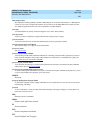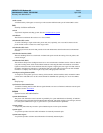
DEFINITY ECS Release 8.2
Administrator’s Guide
555-233-506
Issue 1
April 2000
Glossary and abbreviations
1650
PL
Private line
PLS
Premises Lightwave System
PMS
Property Management System
PN
Port network
PNA
Private network access
POE
Processor occupancy evaluation
POP
Point of presence
port
A data- or voice-transmission access point on a device that is used for communicating with other devices.
port carrier
A carrier in a multicarrier cabinet or a single-carrier cabinet containing port circuit packs, power units, and
service circuits. Also called a port cabinet in a single-carrier cabinet.
port network (PN)
A cabinet containing a TDM bus and packet bus to which the following components are connected: port cir-
cuit packs, one or two tone-clock circuit packs, a maintenance circuit pack, service circuit packs, and (option-
ally) up to four expansion interface (EI) circuit packs in DEFINITY ECS. Each PN is controlled either locally
or remotely by a switch processing element (SPE). See also expansion port network (EPN)
and processor port
network (PPN).
port-network connectivity
The interconnection of port networks (PNs), regardless of whether the configuration uses direct or switched
connectivity.
PPM
1. Parts per million
2. Periodic pulse metering
PPN
See processor port network (PPN).
PRI
See Primary Rate Interface (PRI).
primary extension
The main extension associated with the physical voice or data terminal.
Primary Rate Interface (PRI)
A standard ISDN frame format that specifies the protocol used between two or more communications sys-
tems. PRI runs at 1.544 Mbps and, as used in North America, provides 23 64-kbps B-channels (voice or data)
and one 64-kbps D-channel (signaling). The D-channel is the 24th channel of the interface and contains mul-
tiplexed signaling information for the other 23 channels.


















